Energy Loss in Steep Open Channels with Step-Pools
Abstract
1. Introduction
2. Methodology
2.1. Description of CFD Model
2.2. Testing and Validation of ANSYS-CFX
2.3. Numerical Experiments for Energy Loss
2.4. Dimensionless Parameters for Energy Loss
3. Results and Discussions
3.1. Effect of Flow Rate
3.2. Effect of Horizontal and Vertical Face Inclinations
3.3. Multiple Step-Pools
4. Conclusions
- (i)
- For a given step-pool channel, three distinct flow regimes: Nappe, transition and skimming, could be identified as the flow rate increased from low to high.
- (ii)
- In the numerical experiments conducted for nappe flow, the energy loss decreased as the flow rate increased. However, this decrease is marginal and the energy loss was more or less constant at 0.15 m. Energy loss increased from 0.18 m to 0.55 m while the flow regime changed from transition to skimming.
- (iii)
- Darcy Weisbach friction factor high at low flow rate (0.015 m2 s−1 to 0.075 m2 s−1) and decreased at higher flow rates (0.075 m2 s−1 to 0.55 m2 s−1) in step-pool system.
- (iv)
- Energy loss in step-pools is positively correlated with the size of recirculation zone, velocity in the recirculation zone, vorticity and the spatial extent over which the vorticity is high.
- (v)
- When horizontal face inclination was increased from 2° to 10°, energy loss increased by 31.6% and Darcy Weisbach friction factor fluctuated; further investigation is required to understand this behavior.
- (vi)
- When vertical step inclination was increased from 40° to 70°, energy loss and Darcy Weisbach friction factor decreased by 58.6% and 75%, respectively.
- (vii)
- The behavior of step-pool sequence for nappe and transition flow regimes was markedly different from that for skimming flow regime. Energy loss is linearly related to the number of step-pools for nappe and transition flows, whereas it is a nonlinear function for skimming flows.
Supplementary Materials
Author Contributions
Funding
Data Availability Statement
Acknowledgments
Conflicts of Interest
References
- Alonso, R.L.; Fernández, J.B.; Cugat, M.À.C. Flow resistance equations for mountain rivers. Investig. Agrar. Sist. Recur. For. 2009, 18, 81–91. [Google Scholar]
- Chin, A. The geomorphic significance of step-pools in mountain streams. Geomorphology 2003, 55, 125–137. [Google Scholar] [CrossRef]
- Kumar, R.; Devi, K.R. Conservation of freshwater habitats and fishes in the Western Ghats of India. Int. Zoo Yearb. 2013, 47, 71–80. [Google Scholar] [CrossRef]
- Maloney, K.O.; Munguia, P.; Mitchell, R.M. Anthropogenic disturbance and landscape patterns affect diversity patterns of aquatic benthic macroinvertebrates. J. N. Am. Benthol. Soc. 2011, 30, 284–295. [Google Scholar] [CrossRef]
- Yochum, S.E.; Bledsoe, B.P.; David, G.C.L.; Wohl, E. Velocity prediction in high-gradient channels. J. Hydrol. 2012, 424–425, 84–98. [Google Scholar] [CrossRef]
- Campisano, A.; Creaco, E.; Modica, C. Nondimensional simulation-based regression formulas for slit dam design in mountain rivers. J. Hydraul. Eng. 2018, 144, 1–10. [Google Scholar] [CrossRef]
- Comiti, F.; Mao, L.; Wilcox, A.; Wohl, E.E.; Lenzi, M.A. Field-derived relationships for flow velocity and resistance in high-gradient streams. J. Hydrol. 2007, 340, 48–62. [Google Scholar] [CrossRef]
- Nickolotsky, A.; Pavlowsky, R.T. Morphology of step-pools in a wilderness headwater stream: The importance of standardizing geomorphic measurements. Geomorphology 2007, 83, 294–306. [Google Scholar] [CrossRef]
- Chin, A.; Phillips, J.D. The self-organization of step-pools in mountain streams. Geomorphology 2007, 83, 346–358. [Google Scholar] [CrossRef]
- Recking, A.; Leduc, P.; LieBault, F.; Church, M. A field investigation of the influence of sediment supply on step-pool morphology and stability. Geomorphology 2012, 139–140, 53–66. [Google Scholar] [CrossRef]
- Chartrand, S.M.; Jellinek, M.; Whiting, P.J.; Stamm, J. Geometric scaling of step-pools in mountain streams: Observations and implications. Geomorphology 2011, 129, 141–151. [Google Scholar] [CrossRef]
- Thomas, D.B.; Abt, S.R.; Mussetter, R.A.; Harvey, M.D. A design procedure for sizing step-pool structures. In Proceedings of the Joint Conference on Water Resource Engineering and Water Resources Planning and Management: Building Partenships 2000, Minneapollis, MN, USA, 30 July–2 August 2000. [Google Scholar]
- Zhao-Yin, W.; Charles, S.M.; Xue-Hua, D.; Guo-An, Y. Ecological and hydraulic studies of step-pool systems. J. Hydraul. Eng. 2009, 135, 705–717. [Google Scholar]
- Kalathil, S.T.; Chandra, V. Review of step-pool hydro dynamics in mountain streams. Prog. Phys. Geog. 2019, 43, 607–626. [Google Scholar] [CrossRef]
- Maxwell, A.R.; Papanicolaou, A.N. Geometric characteristics of step-pool streams. In Proceedings of the Joint Conference on Water Resource Engineering and Water Resources Planning and Management: Building Partenships 2000, Minneapollis, MN, USA, 30 July–2 August 2000. [Google Scholar]
- Peterson, D.F.; Mohanty, P.K. Flume studies of flow in steep, rough channels. J. Hydraul. Div. 1960, 86, 55–76. [Google Scholar]
- Sindelar, C.; Smart, G. Transition flow in step pool system: Pressure distribution and drag forces. J. Hydraul. Eng. 2016, 142, 683–688. [Google Scholar] [CrossRef]
- Toombes, L. Experimental study of air-water flow properties on low-gradient stepped cascades. Ph.D. Thesis, University of Queensland, Australia, Brisbane, 2002. [Google Scholar]
- Chinnarasri, C.; Wongwises, S. Flow patterns and energy dissipation over various stepped chutes. J. Irrig. Drain. Eng. 2006, 132, 70–76. [Google Scholar] [CrossRef]
- Pagliara, S.; Dazzini, D. Hydraulics of block ramp for river restoration. In Proceedings of the 2nd International Conference on New Trends in Water and Environmental Engineering for Safety and Life: Eco-compatible Solution for Aquatic Environments 2002, Capri, Italy, 24–28 June 2002; pp. 165–166. [Google Scholar]
- David, G.C.L.; Wohl, E.; Yochum., S.E.; Bledsoe, B.P. Controls on spatial variations in flow resistance along steep mountain streams. Water Resour. Res. 2010, 46, 1–21. [Google Scholar] [CrossRef]
- Kaufmann, P.R.; Faustini, J.M.; Larsen, D.P.; Shirazi, M.A. A roughness-corrected index of relative bed stability for regional stream surveys. Geomorphology 2008, 99, 150–170. [Google Scholar] [CrossRef]
- Lee, A.J.; Ferguson, R.I. Velocity and flow resistance in step-pool streams. Geomorphology 2002, 46, 59–71. [Google Scholar] [CrossRef]
- Comiti, F.; Cadol, D.; Wohl, E. Flow regimes, bed morphology, and flow resistance in self-formed step-pool channels. Water Resour. Res. 2009, 45, 1–18. [Google Scholar] [CrossRef]
- Felder, S. Air-Water Flow Properties on Stepped Spillways for Embankment Dams: Aeration, Energy Dissipation and Turbulence on Uniform, Non-Uniform and Pooled Stepped Chutes. Ph.D. Thesis, University of Queensland, Brisbane, Australia, 2013. [Google Scholar]
- Felder, S.; Fromm, C.; Chanson, H. Air Entrainment and Energy Dissipation on a 8.9 Slope Stepped Spillway with Flat and Pooled Steps; University of Queensland: Brisbane, Australia, 2012. [Google Scholar]
- Agostino, V.D.; Michelini, T. On kinematics and flow velocity prediction in step-pool channels. Water Resour. Res. 2015, 51, 4650–4667. [Google Scholar] [CrossRef]
- Andre, S. High Velocity Aerated Flows on Stepped Chutes with Macro-Roughness Elements. Ph.D. Thesis, Swiss Federal Institute of Technology Lausanne, Lausanne, Switzerland, 2004. [Google Scholar]
- Nikseresht, A.H.; Talebbeydokhti, N.; Rezaei, M.J. Numerical simulation of two-phase flow on step-pool spillways. Sci. Iran. 2013, 20, 222–230. [Google Scholar]
- Peyras, L.; Royet, P.; Degoutte, G. Flow and energy dissipation over stepped gabion weirs. J. Hydraul. Eng. 1992, 118, 707–717. [Google Scholar] [CrossRef]
- Baki, A.B.M.; Zhu, D.Z.; Rajaratnam, N. Flow simulation in a rock-ramp fish pass. J. Hydraul. Eng. 2016, 142, 04016031. [Google Scholar] [CrossRef]
- Baki, A.B.M.; Zhu, D.Z.; Harwood, A.; Lewis, A.; Healey, K. Rock-weir fishway I: Flow regimes and hydraulic characteristics. J. Ecohydraul. 2017, 2, 122–141. [Google Scholar] [CrossRef]
- Marriner, B.A.; Baki, A.B.M.; Zhu, D.Z.; Thiem, J.D.; Cooke, S.J.; Katopodis, C. Field and numerical assessment of turning pool hydraulics in a vertical slot fishway. Ecol. Eng. 2014, 63, 88–101. [Google Scholar] [CrossRef]
- Salaheldin, T.M.; Imran, J.; Chaudhry, M.H. Numerical modeling of three-dimensional flow field around circular piers. J. Hydraul. Eng. 2004, 130, 91–100. [Google Scholar] [CrossRef]
- Thappeta, S.K.; Bhallamudi, S.M.; Fiener, P.; Narasimhan, B. Resistance in steep open channels due to randomly distributed macro roughness elements at large Froude numbers. J. Hydrol. Eng. 2017, 22, 1–15. [Google Scholar] [CrossRef]
- Chen, Q.; Dai, G.; Liu, H. Volume of fluid model for turbulence numerical simulation of stepped spillway overflow. J. Hydraul. Eng. 2002, 128, 683–688. [Google Scholar] [CrossRef]
- Heidari, A.; Ghasemi, P. Evaluation of step’s slope on energy dissipation in stepped spillway. Int. J. Eng. Technol. 2014, 3, 501. [Google Scholar] [CrossRef][Green Version]
- Chiu, C.L.; Fan, C.M.; Tsung, S.C. Numerical modeling for periodic oscillation of free over fall in a vertical drop pool. J. Hydraul. Eng. 2016, 143, 04016077. [Google Scholar] [CrossRef]
- Bombardelli, F.A.; Meireles, I.; Matos, J. Laboratory measurements and multi-block numerical simulations of the mean flow and turbulence in the non-aerated skimming flow region of steep stepped spillways. Environ. Fluid Mech. 2011, 11, 263–288. [Google Scholar] [CrossRef]
- Morovati, K.H.; Eghbalzadeh, A. Study of inception point, void fraction and pressure over pooled stepped spillways using FLOW-3D. Int. J. Numer. Methods Heat Fluid Flow 2018, 28, 982–998. [Google Scholar] [CrossRef]
- Bayon, A.; Valero, D.; Garcia-Bartual, R.; Valles-Moran, F.J.; Lopez-Jimenez, P.A. Performance assessment of OpenFOAM and FLOW-3D in the numerical modeling of a low Reynolds number hydraulic jump. Environ. Model. Softw. 2016, 80, 322–335. [Google Scholar] [CrossRef]
- Valero, D.; Bung, D.B.; Crookston, B.M. Energy dissipation of a Type III basin under design and adverse conditions for stepped and smooth spillways. J. Hydraul. Eng. 2018, 144, 04018036. [Google Scholar] [CrossRef]
- Abdulla, A.A. Three-Dimensional Flow Model for Different Cross-Section High-Velocity Channels. Ph.D. Thesis, University of Plymouth, Plymouth, UK, 2013. [Google Scholar]
- Spalart, P.R.; Shur, M. On the sensitization of turbulence model to rotation and curvature. Aerosp. Sci. Tech. 1997, 1, 297–302. [Google Scholar] [CrossRef]
- ANSYS-CFX. Solver Theory Guide; ANSYS: Canonsburg, PA, USA, 2014. [Google Scholar]
- Jone, W.P.; Launder, B.E. The prediction of laminarization with a two-equation model of turbulence. Int. J. Heat Mass Transf. 1972, 15, 301–314. [Google Scholar] [CrossRef]
- Hirt, C.W.; Nichols, B.D. Volume of fluid (VOF) method for the dynamics of free boundaries. J. Comput. Phys. 1981, 39, 201–225. [Google Scholar] [CrossRef]
- Castillo, L.G.; Carrillo, J.M.; García, J.T.; Vigueras-Rodríguez, A. Numerical simulations and laboratory measurements in hydraulic jumps. In Proceedings of the 11th International Conference on Hydroinformatics 2014, New York, NY, USA, 17–21 August 2014. [Google Scholar]
- Xiang, M.; Cheung, S.C.P.; Tu, J.Y.; Zhang, W.H. A multi-fluid modelling approach for the air entrainment and internal bubbly flow region in hydraulic jumps. Ocean Eng. 2014, 91, 51–63. [Google Scholar] [CrossRef]
- Israngkura, U.; Chinnarasri, C. Flow depth and energy losses through stepped chutes. In Proceedings of the 9th Congress of the Asian and Pacific Division of the International Association for Hydraulic Research 1994, Singapore, 24–26 August 1994; pp. 156–163. [Google Scholar]

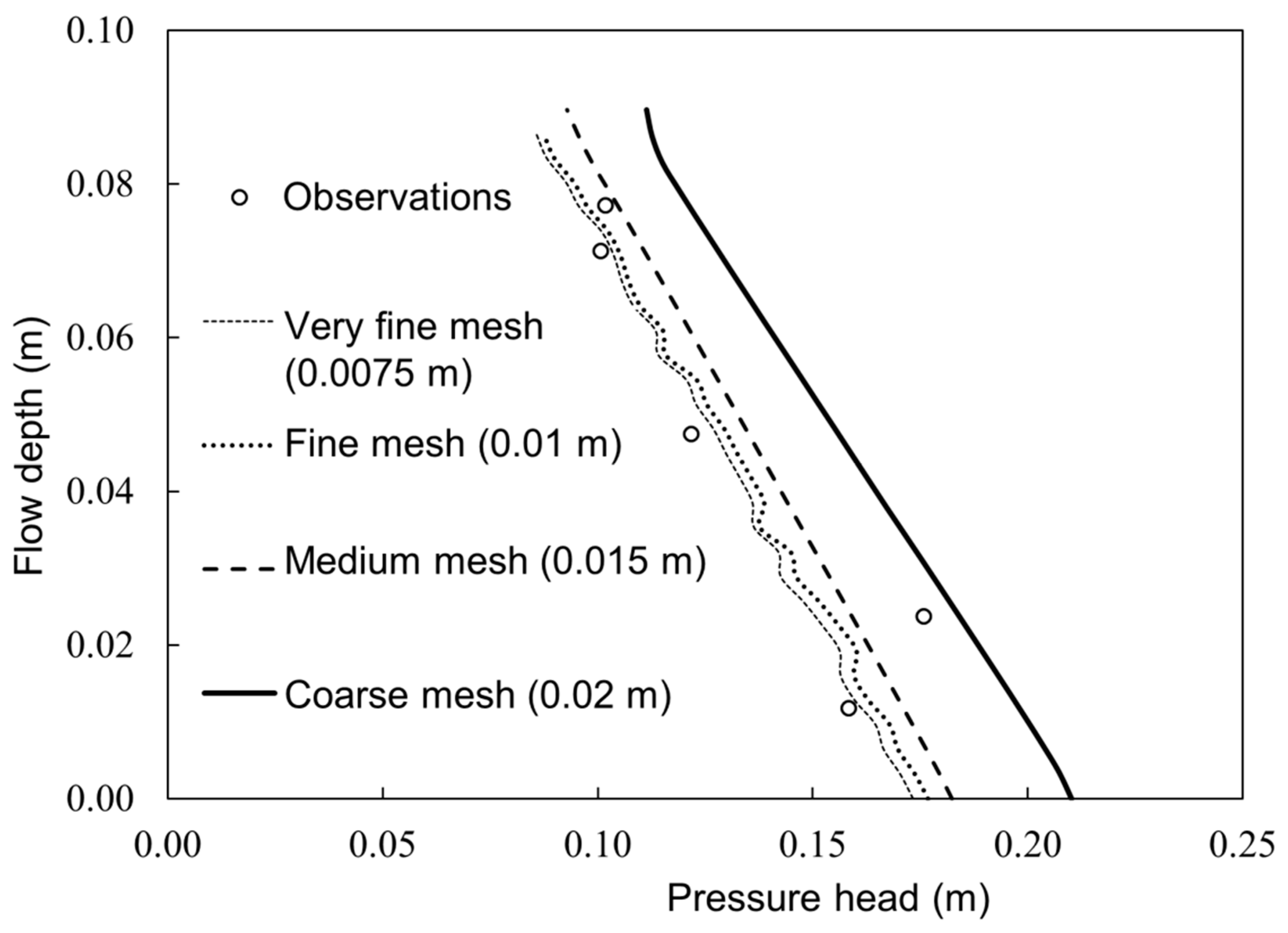

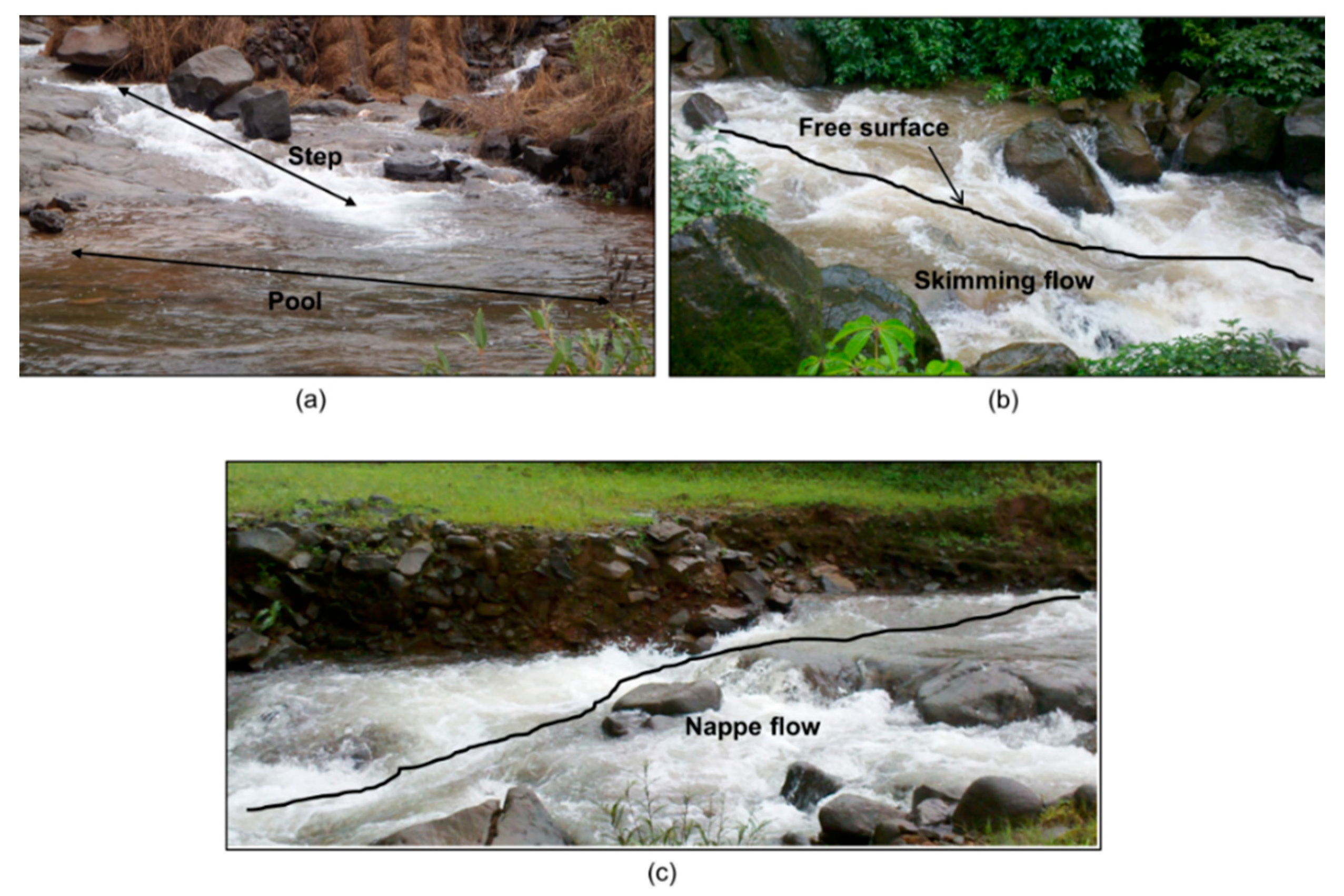

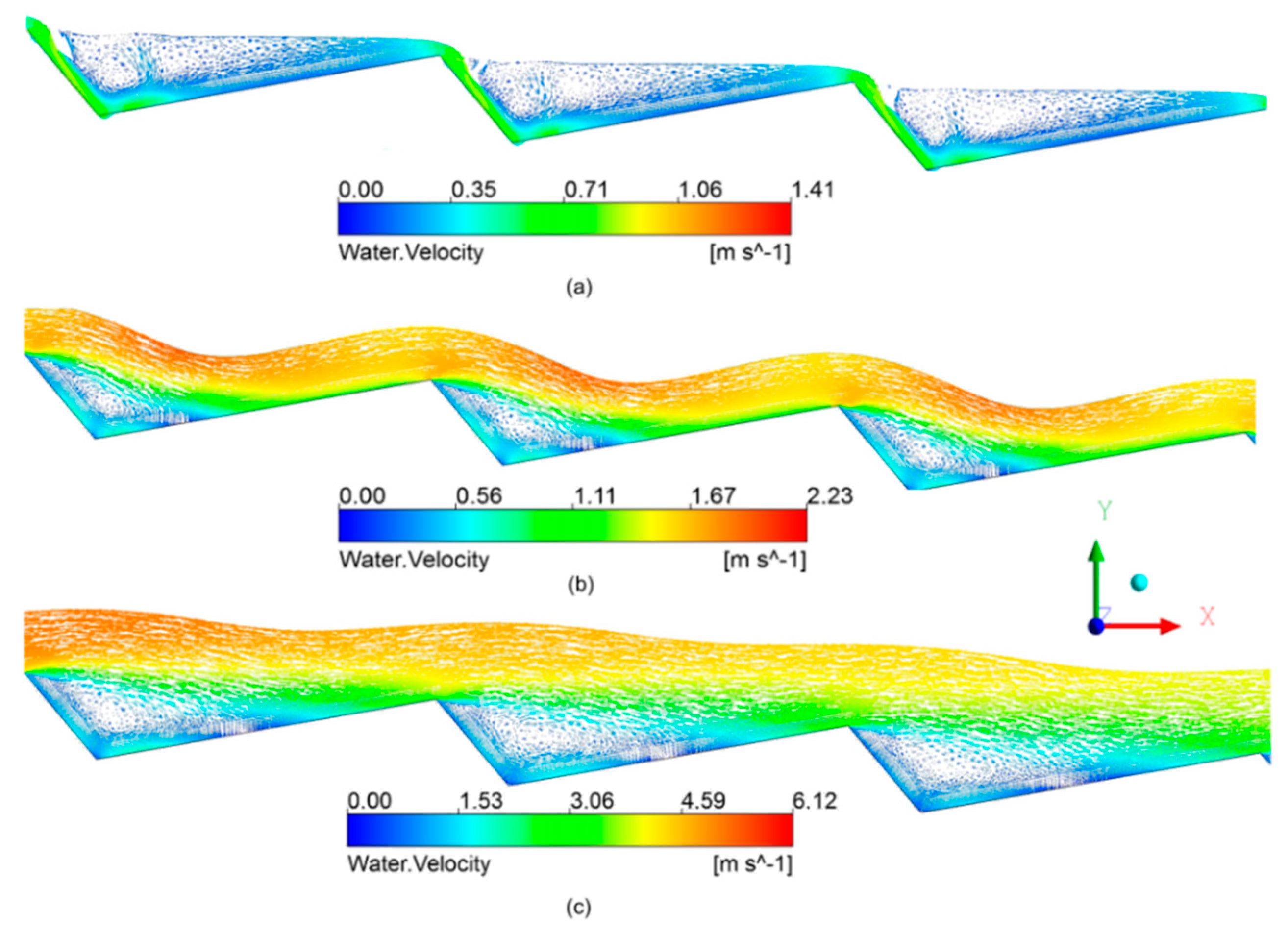
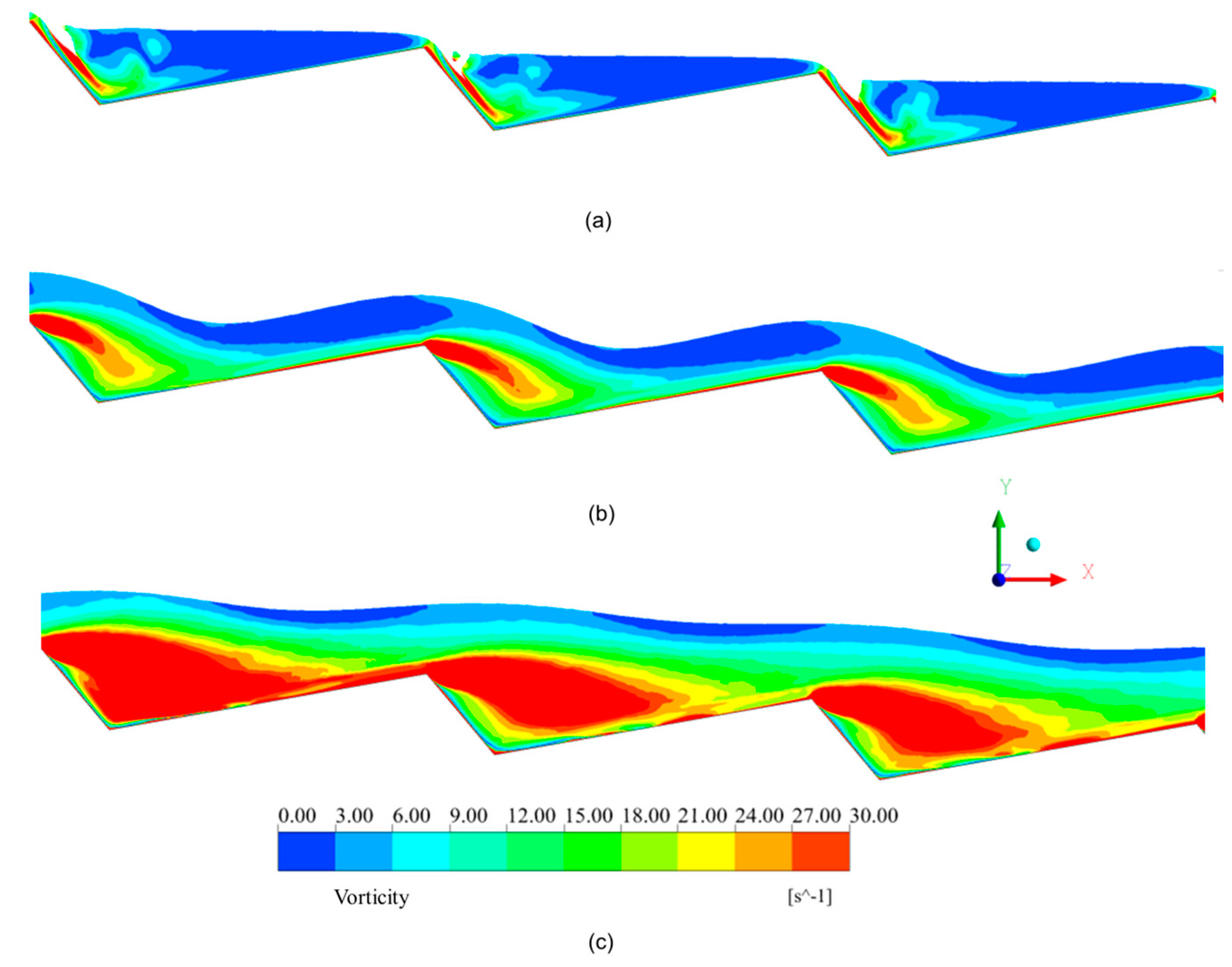

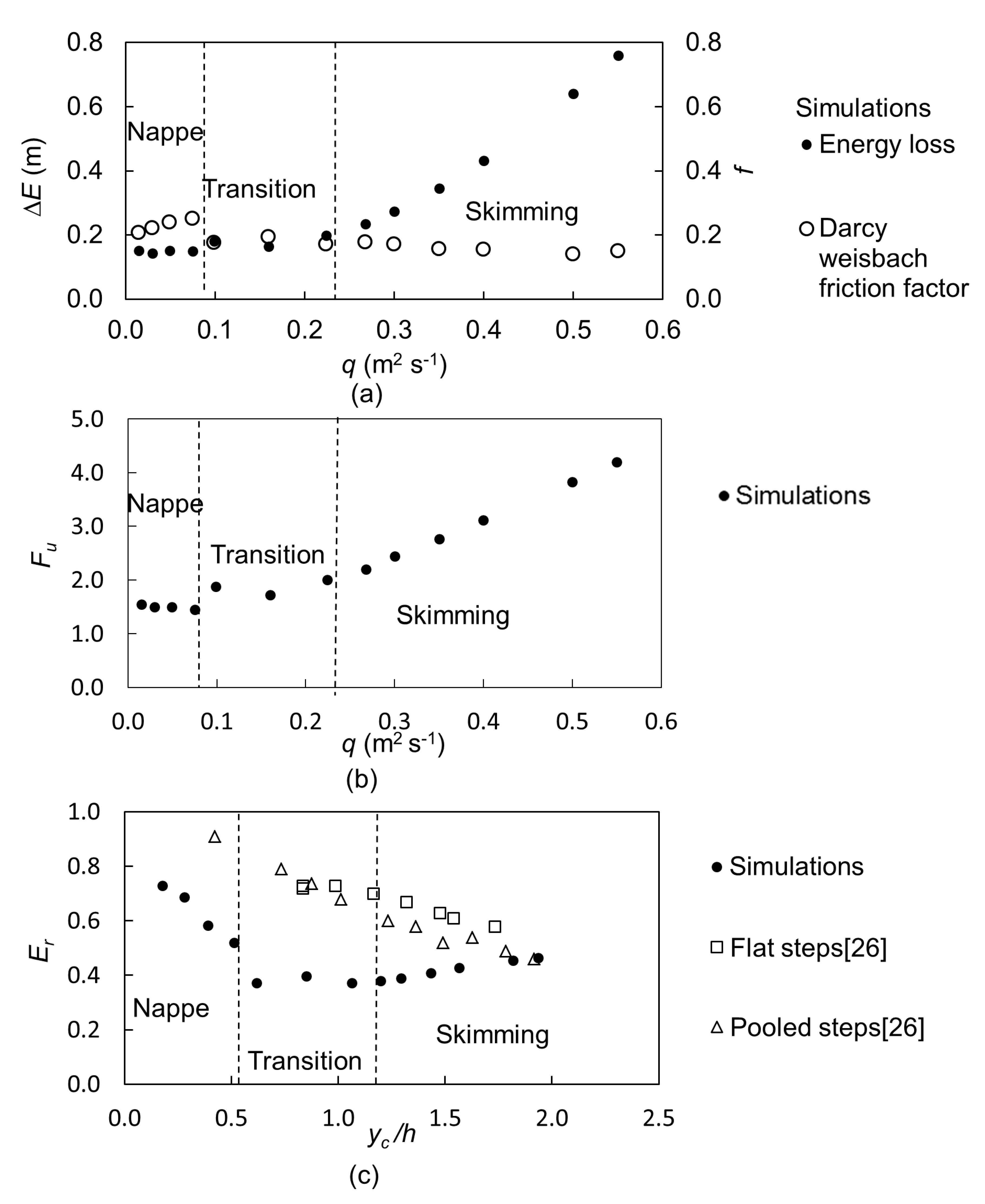
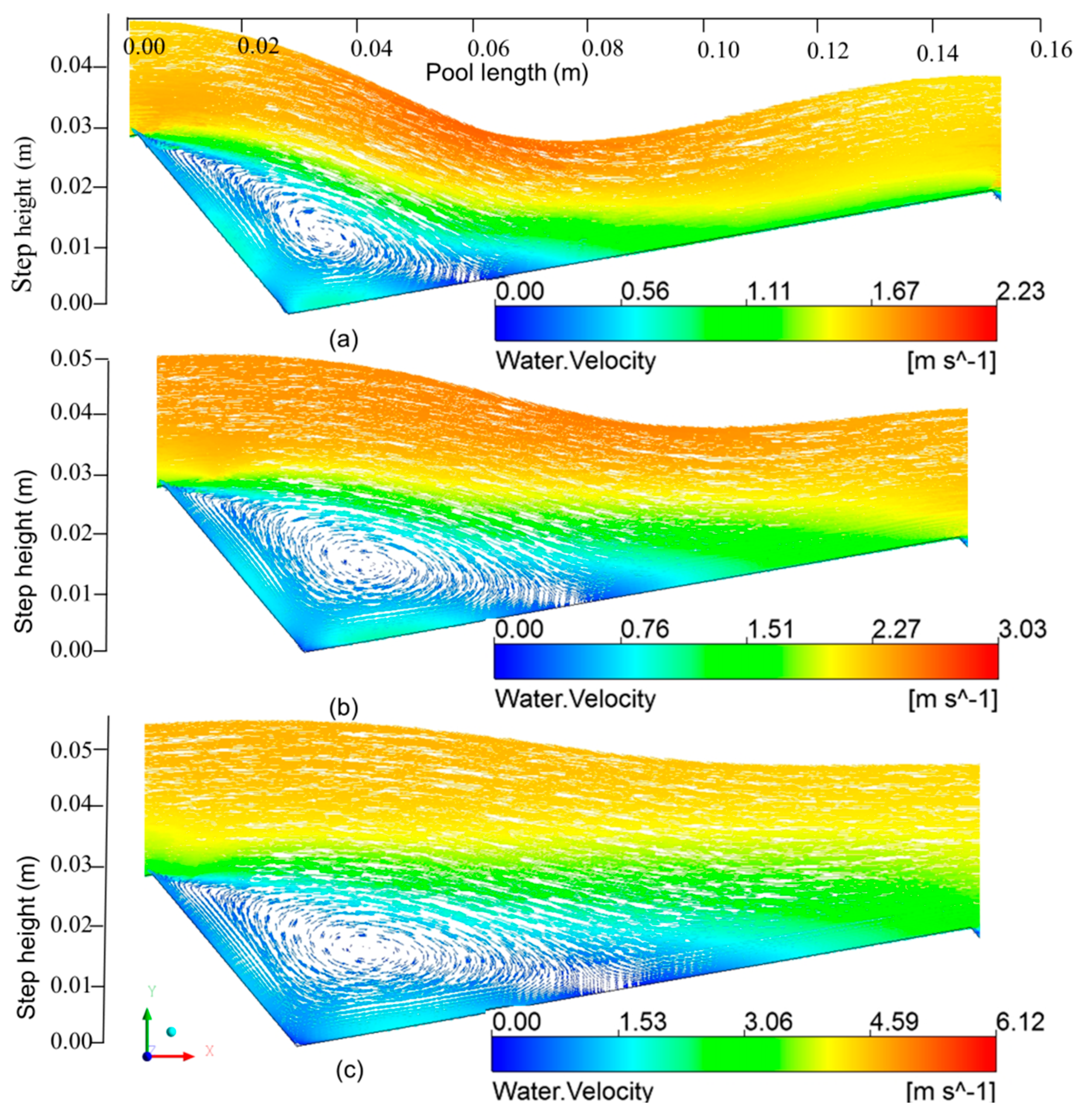
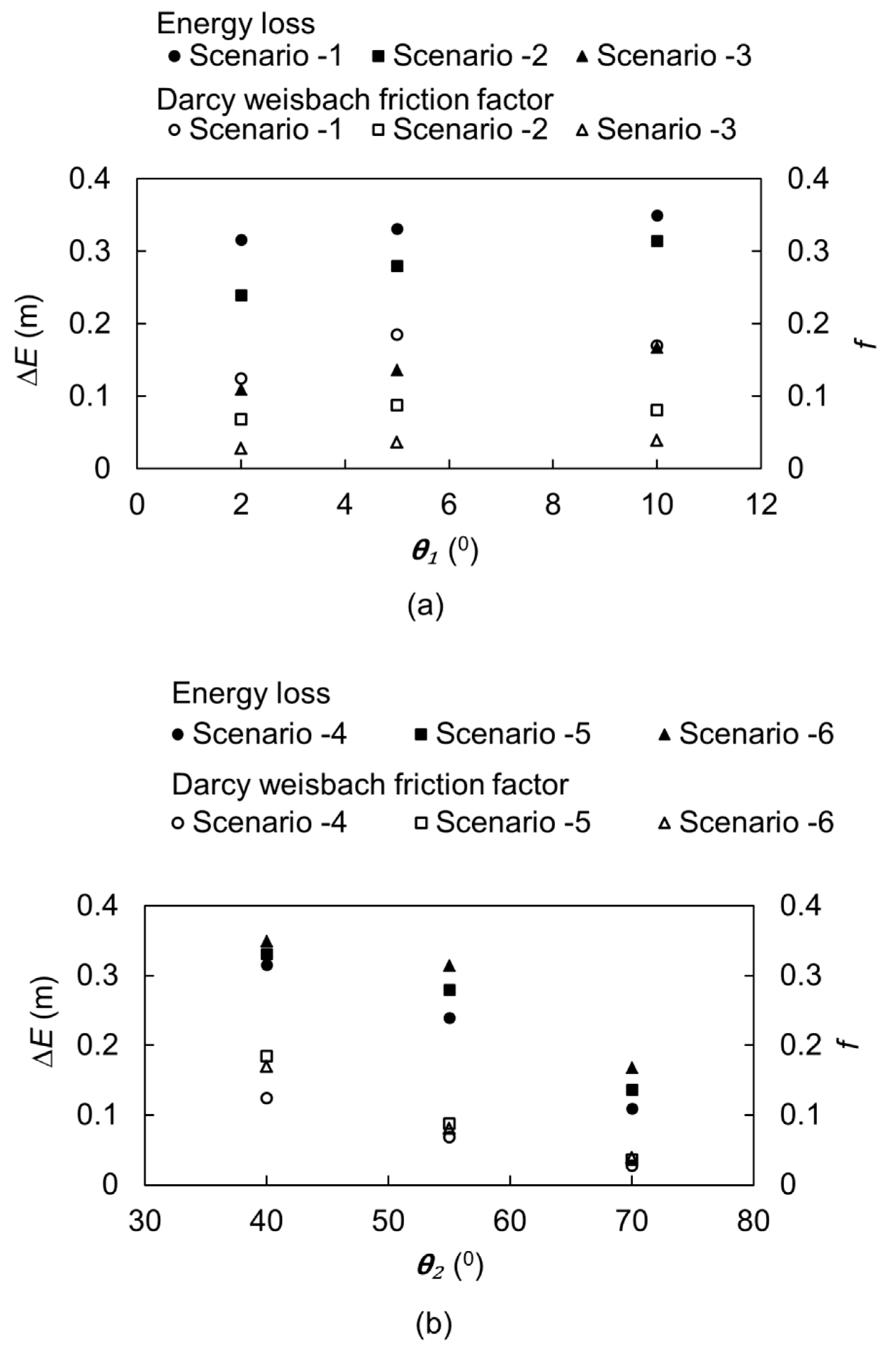


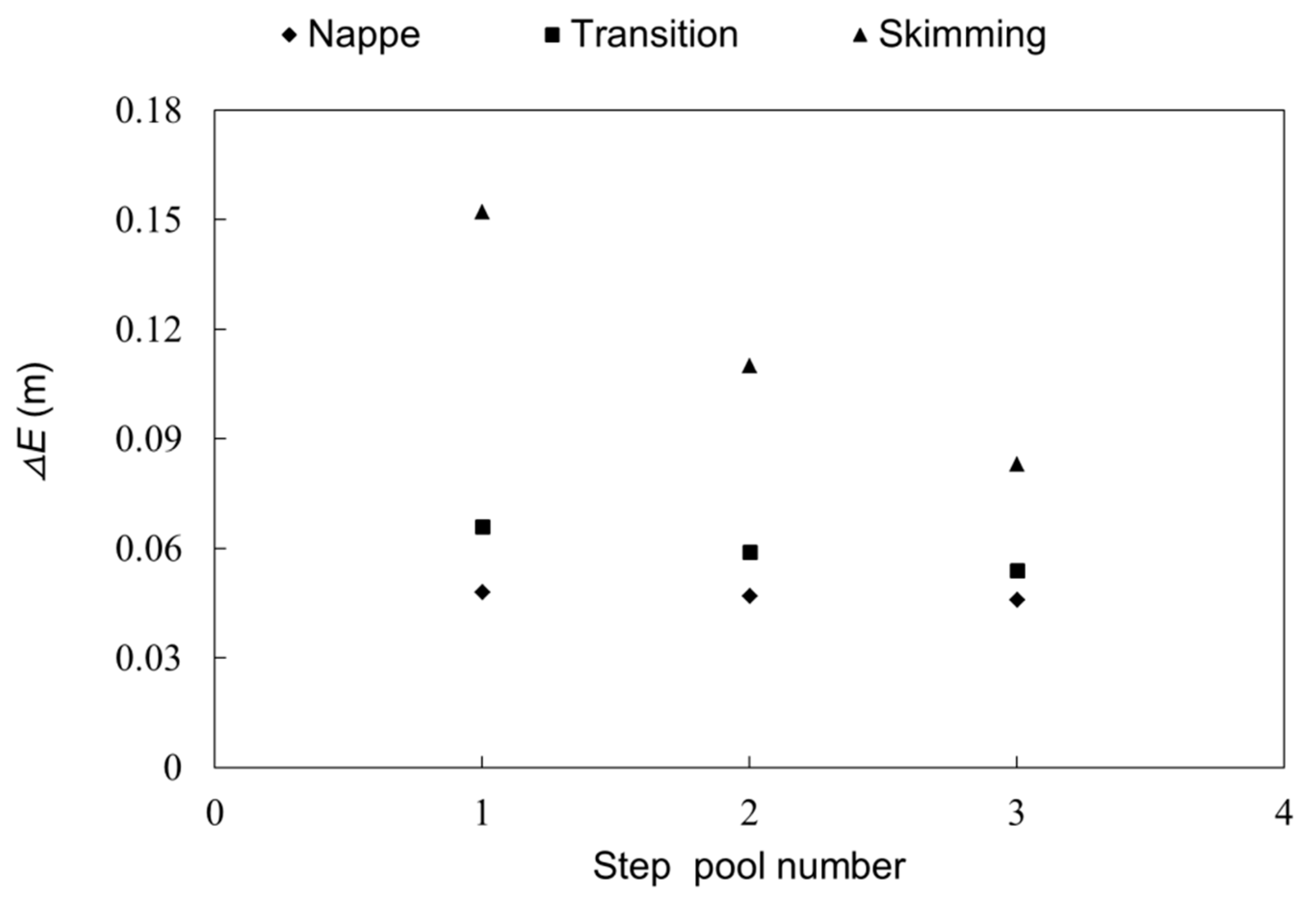
| Test Case | Type of Experiment | Length (m) | Width (m) | No | Step Height (m) | Flow Rate (m3 s−1) | Measuring Technique | Data Type | Author |
|---|---|---|---|---|---|---|---|---|---|
| 1 | Stepped Spillway (varying step size) | 3.00 | 0.30 | 10 | 0.02 to 0.06 | 0.02 | Piezometers | Pressure | Chen et al. [36] |
| 2 | Stepped Spillway (uniform step size) | 2.12 | 0.40 | 18 | 0.10 | 0.004 to 0.068 | - | Energy Loss | Chinnarasri and Wongwises [19] |
| 3 | Step-Pool System | 6.00 | 0.76 | 9 | 0.08 | 0.150 | Pressure Transducers | Pressure Head profile | Sindelar and Smart [17] |
| Test Case | RMSE | Bias | E |
|---|---|---|---|
| 1 (pressure; present) | 0.56 to 1.03 Kpa | 0.76 to 1.01 Kpa | 0.65 to 0.93 |
| 1 (pressure; Chen et al. [36]) | 0.61 to 1.60 Kpa | −0.88 to −1.29 Kpa | 0.65 to 0.85 |
| 2 (Figure 3g) | 0.164 m | −0.155 m | 0.567 |
| 2 (Figure 3h) | 0.094 | −0.074 | 0.526 |
| 3 | 0.012 to 0.037 m | −0.028 to 0.006 m | 0.85 to 0.96 |
| Run No | Slope (°) | (°) | (°) | q (m2 s−1) | Flow Regime |
|---|---|---|---|---|---|
| 1 | 7.7 | 10 | 40 | 0.015 | Nappe |
| 2 | 7.7 | 10 | 40 | 0.030 | Nappe |
| 3 | 7.7 | 10 | 40 | 0.050 | Nappe |
| 4 | 7.7 | 10 | 40 | 0.075 | Nappe |
| 5 | 7.7 | 10 | 40 | 0.099 | Transition |
| 6 | 7.7 | 10 | 40 | 0.160 | Transition |
| 7 | 7.7 | 10 | 40 | 0.224 | Transition |
| 8 | 7.7 | 10 | 40 | 0.268 | Skimming |
| 9 | 7.7 | 10 | 40 | 0.300 | Skimming |
| 10 | 7.7 | 10 | 40 | 0.350 | Skimming |
| 11 | 7.7 | 10 | 40 | 0.400 | Skimming |
| 12 | 7.7 | 10 | 40 | 0.500 | Skimming |
| 13 | 7.7 | 10 | 40 | 0.550 | Skimming |
| Run No | Slope (°) | q (m2 s−1) | Scenarios | |||
|---|---|---|---|---|---|---|
| 14 | 8.0 | 0.21 | 2 | 40 | 0.224 | Scenario 1 |
| 15 | 7.9 | 5 | ||||
| 07 | 7.8 | 10 | ||||
| 16 | 10.5 | 2 | 55 | Scenario 2 | ||
| 5 | ||||||
| 17 | 8.5 | 10 | ||||
| 18 | 5.0 | |||||
| 19 | 11.0 | 2 | 70 | Scenario 3 | ||
| 20 | 9.8 | 5 | ||||
| 21 | 7.8 | 10 |
Publisher’s Note: MDPI stays neutral with regard to jurisdictional claims in published maps and institutional affiliations. |
© 2020 by the authors. Licensee MDPI, Basel, Switzerland. This article is an open access article distributed under the terms and conditions of the Creative Commons Attribution (CC BY) license (http://creativecommons.org/licenses/by/4.0/).
Share and Cite
Thappeta, S.K.; Bhallamudi, S.M.; Chandra, V.; Fiener, P.; Baki, A.B.M. Energy Loss in Steep Open Channels with Step-Pools. Water 2021, 13, 72. https://doi.org/10.3390/w13010072
Thappeta SK, Bhallamudi SM, Chandra V, Fiener P, Baki ABM. Energy Loss in Steep Open Channels with Step-Pools. Water. 2021; 13(1):72. https://doi.org/10.3390/w13010072
Chicago/Turabian StyleThappeta, Suresh Kumar, S. Murty Bhallamudi, Venu Chandra, Peter Fiener, and Abul Basar M. Baki. 2021. "Energy Loss in Steep Open Channels with Step-Pools" Water 13, no. 1: 72. https://doi.org/10.3390/w13010072
APA StyleThappeta, S. K., Bhallamudi, S. M., Chandra, V., Fiener, P., & Baki, A. B. M. (2021). Energy Loss in Steep Open Channels with Step-Pools. Water, 13(1), 72. https://doi.org/10.3390/w13010072







